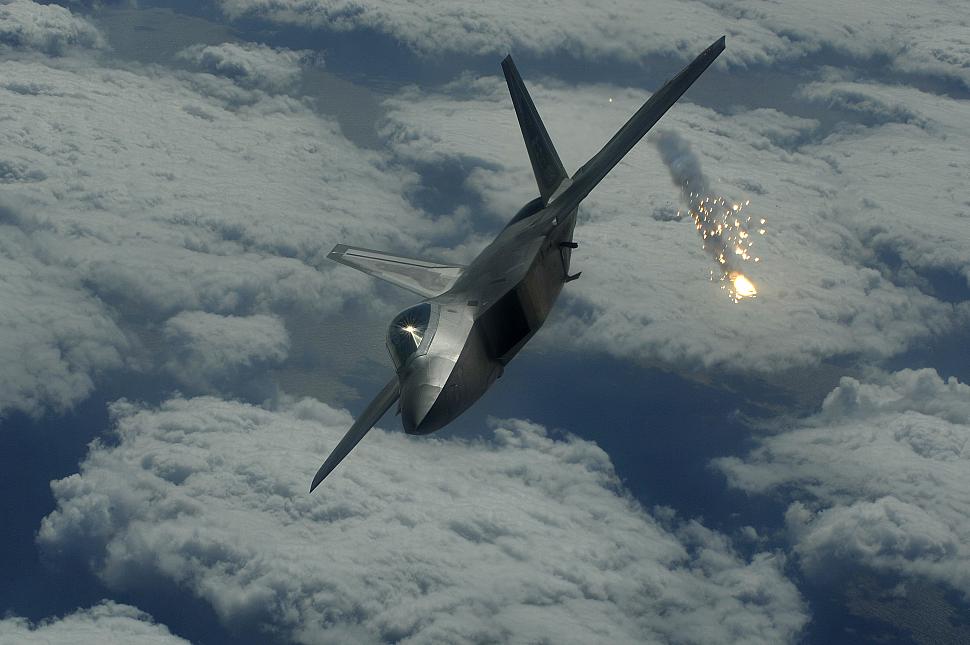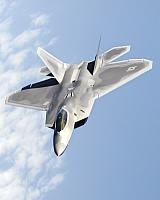Fighter Jet News
F-22 Raptor News
F-22A Raptors roaming skies over Okinawa
February 3, 2009 (by
Natasha Lee) -
Air Force F-22A Raptors are surreptitiously roaming the Pacific skies to train and provide security support to the Western Pacific.

Twelve of the stealthy fighters, assigned to the 27th Fighter Squadron, arrived at Kadena Air Base from Langley Air Force Base in Virginia last month and will be deployed in Okinawa for about three months.
This is the second deployment for the squadron, which debuted the jets at Kadena in 2007.
Another dozen or so Raptors from Elmendorf Air Force Base in Alaska are participating in a similar deployment rotation at Andersen Air Force Base on Guam.
The goal this time around, said squadron commander Lt. Col. Lansing Pilch, is to focus on improving joint combat capabilities with Kadena's fighter squadrons and Navy and Marine assets.
The Raptor can perform air-to-air and air-to-ground missions.
About 250 maintenance and combat support personnel from the 27th Fighter Squadron accompanied the aircraft, Kadena officials said.
"It's an outstanding opportunity to fly with pilots that have never flown with the F-22s before," Pilch said. "It allows us to be a stronger fighter force."
The F-22A can cruise at supersonic speeds and evade radar detection, making it virtually invisible to threats.
The Raptors, which became operational in 2005, are also the military’s most costly jets — running about $142 million each, according to an Air Force fact sheet said. The jets are eventually to replace the Air Force’s aging fleet of F-15s.
Staff Sgt. Wesley Goff, an avionics specialist with the 27th Fighter Squadron who helps maintain the F-22As, said understanding the jet's mechanics and technology takes some adjustment.
Goff has worked on F-117A, the Air Force's first stealth fighter, and said the strides in aviation technology are impressive.
"Just the nature of its (F-22A's) capabilities is unbelievable," Goff said.
More than 100 pilots have been trained to fly the F-22A, Pilch said.
Pilch, who's flown F-15s and F-16s, said the F-22A's design, speed and avionics technology gives him greater depth in tactical situations.
"It makes the aircraft extremely capable, it has great maneuverability, and it allows me to have a great picture of what’s going on around me," Pilch said. "Everyone wants to say their jet is the best, but this is it."

USAF F-22A block 20 no. 03-4049 shoots out a flare during an air combat training mission on January 15th, 2009. The F-22A is deployed to Kadena AB, Japan from the 27th FS Langley AFB in support of U.S. Pacific Command. [USAF photo by SrA. Clay Lancaster]
This is the second deployment for the squadron, which debuted the jets at Kadena in 2007.
Another dozen or so Raptors from Elmendorf Air Force Base in Alaska are participating in a similar deployment rotation at Andersen Air Force Base on Guam.
The goal this time around, said squadron commander Lt. Col. Lansing Pilch, is to focus on improving joint combat capabilities with Kadena's fighter squadrons and Navy and Marine assets.
The Raptor can perform air-to-air and air-to-ground missions.
About 250 maintenance and combat support personnel from the 27th Fighter Squadron accompanied the aircraft, Kadena officials said.
"It's an outstanding opportunity to fly with pilots that have never flown with the F-22s before," Pilch said. "It allows us to be a stronger fighter force."
The F-22A can cruise at supersonic speeds and evade radar detection, making it virtually invisible to threats.
The Raptors, which became operational in 2005, are also the military’s most costly jets — running about $142 million each, according to an Air Force fact sheet said. The jets are eventually to replace the Air Force’s aging fleet of F-15s.
Staff Sgt. Wesley Goff, an avionics specialist with the 27th Fighter Squadron who helps maintain the F-22As, said understanding the jet's mechanics and technology takes some adjustment.
Goff has worked on F-117A, the Air Force's first stealth fighter, and said the strides in aviation technology are impressive.
"Just the nature of its (F-22A's) capabilities is unbelievable," Goff said.
More than 100 pilots have been trained to fly the F-22A, Pilch said.
Pilch, who's flown F-15s and F-16s, said the F-22A's design, speed and avionics technology gives him greater depth in tactical situations.
"It makes the aircraft extremely capable, it has great maneuverability, and it allows me to have a great picture of what’s going on around me," Pilch said. "Everyone wants to say their jet is the best, but this is it."
Published on February 03, 2009 in the Pacific edition of Stars and Stripes.
Used with permission from Stars and Stripes, a DoD publication.
© 2009 Stars and Stripes.
Related articles:
Forum discussion:
Tags
- Raptors begin training with 18th Wing ( 2009-01-15)
- F-22 Raptors scheduled to arrive on Andersen ( 2009-01-12)
- Raptors return to the Pacific ( 2009-01-10)
- 27th FS deploys to Western Pacific ( 2009-01-07)
- F-22As scheduled to deploy to Japan & Guam ( 2008-12-16)
- F-22 Raptor news archive
Forum discussion:
- Start a discussion about this article in the F-22 forum.
Tags
Additional images:

A USAF F-22 returns to a mission after receiving fuel from a KC-135 Stratotanker tanker on January 23rd, 2009 over Kadena AB. The F-22 is deployed from the 27th FS based at Langley AFB and the KC-135 is assigned to the 909th ARS from Kadena AB. [USAF photo by MSgt. Andy Dunaway]

A three-ship of F-22 Raptors fly over the Pacific Ocean on January 28th, 2009. The Raptors are deployed from Elmendorf AFB, Alaska, to the 90th EFS at Andersen AFB. Andersen received 12 of the $140 million dollar aircraft and more than 250 Airmen have arrived at the base for a three-month deployment as part of the Pacific's Theater Security Package. [USAF photo MSgt. Kevin J. Gruenwald]

